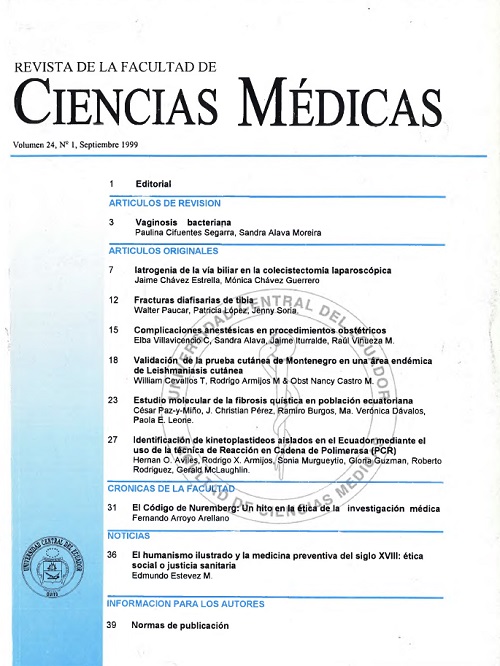Latrogenia de la vía biliar en la colecistectomía laparoscópica
Abstract
Se presenta 6 casos de lesión de la vía biliar en 1.212 colecistectomías laparoscópicas realizadas. Tres lesiones consideradas menores, fueron reconocidas en el
post-operatorio inmediato y 3 lesiones mayores que seccionaron el conducto principal, fueron reconocidas en el acto operatorio por escape de bilis y en dos de ellas con la ayuda de la colangiografía transcística. Proponemos la clasificación de estas lesiones en 5 grados ó tipos:
Tipo I, lesión que produce escape de bilis del cístico, unión císticocoledociana ó de los conductos accesorios.
Tipo II, ligadura y sección del conducto hepático derecho aberrante; Tipo III, lesión puntiforme del conducto biliar común. Tipo IV, sección total, parcial ó ligadura del hepatocolédoco; Tipo V, resección completa de un segmento del conducto mayor o de uno ó mas de los conductos biliares. Se reporta el tratamiento quirúrgico realizado y recomendaciones para prevenir estas lesiones.
Downloads
Metrics
References
2. Bercy G: Extracorporeal show wave litotrypsy of gallstones and the importance of operative cholangiography during Iaparoscopic cholecystectomy. Surg. Endos. 1.990; 4: 13-23.
3. Buess G, Manncke K: Laparoscopic cholecystectomy. Schweiz Rundsch Med. Prax 1.992; 81: 911-913.
4. Schimer B: Complications of laparoscopic cholecystectomy. Current techniques in laparoscopy 1.994; 8: 1-8-13.
5. Belloso R, Ayala L, Souchon E, Henriquez L: Colecistitis aguda. Es un procedimiento laparoscópico? GEN. 1.993; 47: 226-234
6. Dent TL: Training Credentialing and granting of Clinical privileges for laparoscopy General Surgery. Am. Surg. 1.991; 399-403.
7. Ponsky JL: Complications of laparoscopy colecystectomy. Am. J. Surg. 1.991; 161:393-403.
8. Cates J.A, Tompkins RK, Busutil RW: Biliary complications of laparoscopic cholecystectomy. Am. Surg. 1.993; 59: 243-247.
9. Asbun HJ, Rossi RL, Lowell JA Munson JL: Bile dúct injury during laparoscopic cholecystectomy mechanism of injury, prevention and management World J. Surg. 1.993; 17: 547-552.
10. Cueto GJ, Serrano BF, Ramírez AG, Fernández VR: Colecistectomía laparoscópica. Cirujano General 1.991; 13: 52-54.
11. Ponsky JL: Complications of laparoscopy colecystectomy. The Gold Standar. Am. J. Surg. 1.989;158: 174-178.
12. Me Sherry CK: Cholecystectomy. The Gold Standar. Am. J. Surg. 1.989;158: 174-178.
13. Mongenstem L, Wong L, Bercy G: 1.200 open cholecystectomy, before the era laparoscopy: A standard for comparison. Arch. Surg. 1.992; 127: 400-403.
14. Strasberg SM: Collective Review. An analysis of the problem of biliary injury during laparoscopy cholecystectomy. J. Am. Colleg. 1.995; 180: 101-122.
15. Deziel DJ, Keith WM, Steven GE, et al: Complications of laparoscopy cholecystectomy. A national survey of 4.292 hospitals an analysis of 77.604 cases. Am. J. Surg; 1.993; 165: 9-14.
16. National Institutes of Health. Consensus development conference statement no gallstone and laparoscopic cholecystectomy. Am. J. Surg. 1.993; 165: 390-396.
17. Kozareck R, Gannan R, Baerg R: Bile leak after laparoscopic cholecystectomy. Arch. Int. Med; 1.992; 152: 1.040-1.043.
18. Asbum HJ, Rossi R.L, Lowell JA: Bile duct injury during laparoscopic cholecystectomy mechanism of injury prevention and management. World. J. Surg.; 1.993; 17: 547-552.
19. Zucker KA, Curet MJ: Morbilidad y mortalidad en cirugía laparoscópica. Cirugía lap. Me. Graw Hill Inter Am. 2a Ed. 1997: 559-577.
20. Larson GM, Vítale GC, Casey J, Multipractice analysis of laparoscopic cholecystectomy in 1938 patients. Am. J. Surg. 1992; 163: 221-226.
21.Gigot JE, Kestens PJ: Biliary tract injuring during laparoscopic cholecystectomy in Belgium. Results of a multicentric annymous Study. World J. Surg. 1.994;13: 801-805.
22. Chávez EJ, Chávez GM.: Estenosis iatrogénica de la vía biliar principal. Reparación quirúrgica. Metro Ciencia. 1.996; 5 (1): 34-41.
23. Adamsen S, Hansen OH, Jensen H, et al: Bile duct injury during laparoscopic cholecystectomy: A prospective Nation Wide series. Am. J. Surg. 1.997; 184: 571-577.
24. Berci G, Sackier JM, Paaz-Partlouw M: Routine or Selective intraoperative cholangiography during laparoscopic cholecystec-tomy. Am. J. Surg. 1.991; 161: 355-360.
25.Cleir GC, Car-Loche DL, Becher JM, Broocks DC: Routine Cholangiography is not warranted during laparoscopic cholecystectomy. Arch. Surg. 1.993; 128: 51-555.
26. Adams BD, Borowicz MR: Wooton III FT Bile duct complications of other laparoscopic cholecystectomy. Surg. Endose. 1.993; 7: 79-83.
27. Cates JA Tompkins RK, Busuttil RW: Biliary complications of laparoscopic cholecystectomy. Am. Surg. 1.993; 59: 243-247.











